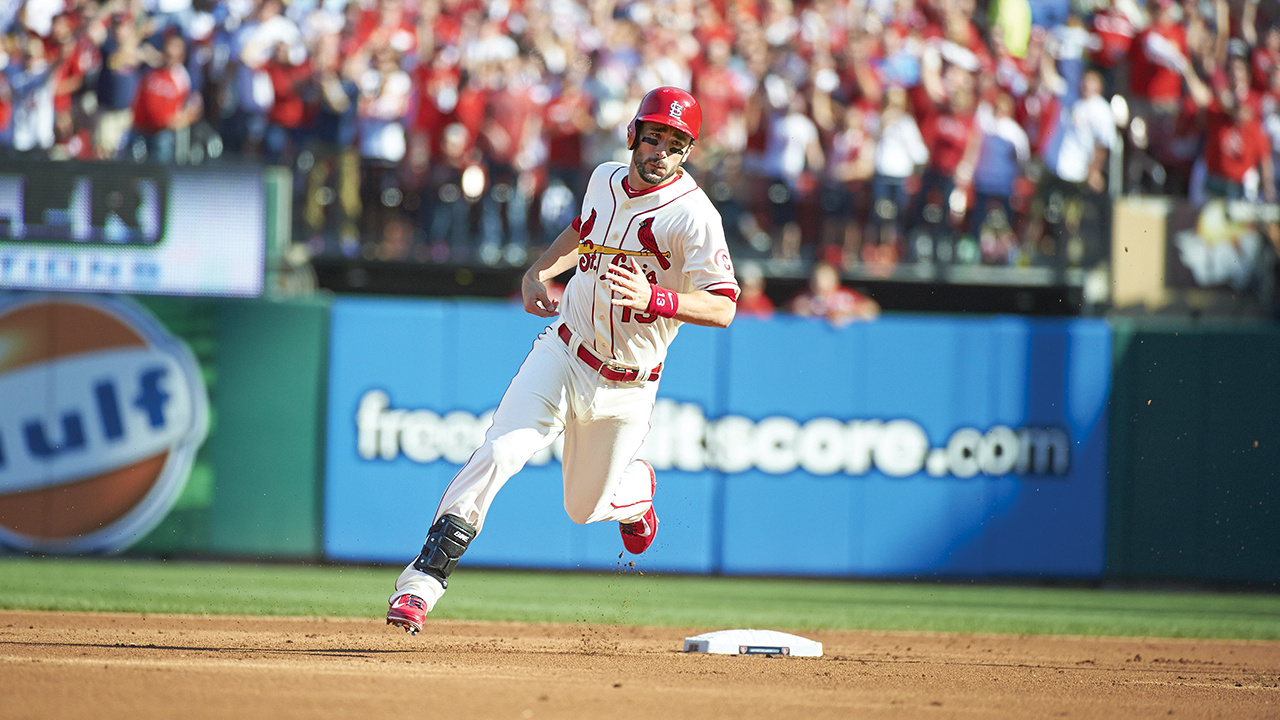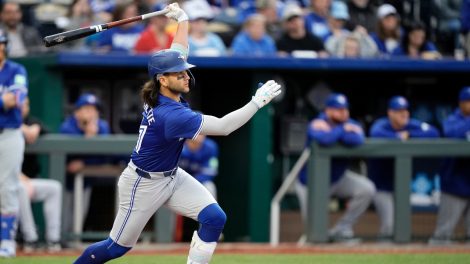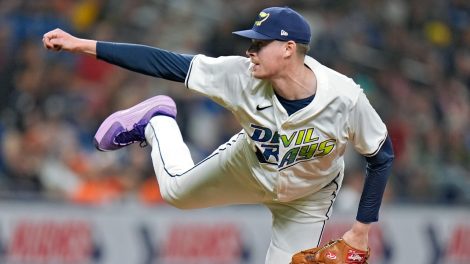This story originally appeared in the March 24, 2014 issue of Sportsnet magazine.
When a new player arrives at spring training with the St. Louis Cardinals, whether a wide-eyed prospect or a well-travelled veteran, the first thing he gets is a book. The Cardinal Way: 86 pages that make up the Cardinals’ bible. There’s a chapter on pitching; there’s a very detailed chapter on catching, written by team manager Mike Matheny, featuring his 16 ideals for a Cardinal behind the dish. There are team policies, bunt plays and guides on infield positioning and conversing with the media. Everything the Cardinals expect of every player in the organization is within those pages, printed in both English and Spanish. And as if that’s not in-depth enough, managers and coaches get copies that are almost 30 pages longer.
The franchise has talked about the “Cardinal Way” theoretically for decades—trumpeting how players, coaches and executives should conduct themselves both on and off the field—but only put it in print a few years ago. The idea was to create a cohesive way of doing business from the lowest rung of the minor-league system all the way to Busch Stadium. So players hit, field and pitch exactly the same way at every level of the organization. The bunt plays in single-A are the same as the ones in the majors. There are no surprises. The theory is that The Cardinal Way prepares players better for the challenges and adjustments necessary once they reach the majors. It makes it easier to step into a Cardinals uniform and contribute right away. Already, other teams around the majors are adopting the approach. Last year, the Chicago Cubs printed their own manual: The Cubs Way.
Whether this is an evolution in a game slow to innovate or just bluster is hard to say. But you can’t argue with results—the Cardinals’ recent success is the envy of baseball. They’ve reached the playoffs in 10 of the past 14 seasons and have had a losing record just once since the turn of the century. Meanwhile, they’ve taken their minor-league system from being ranked worst in MLB by Baseball America in 2006 to best in 2013. In the years between, the Cardinals went to the World Series three times and won it twice. Essentially, they rebuilt without losing. They won in the present while positioning themselves to win in the future. It’s not supposed to work like that.
The organization has its problems, of course, but there are problems and then there are St. Louis Cardinals problems. Like having too many high-end prospects and not enough space on the major-league roster. Like opening 2014 training camp with just five rotation spots for their eight starting pitchers who could land jobs on any other club in the majors. Like having five outfielders who would play every day on most MLB teams. Like having the next generation of Cardinals stars ready and waiting for their shot in the majors, while the current roster just came up two games shy of a World Series title.
And it’s not like the Cardinals aren’t already young. Last year, 36 of the Cardinals’ 97 wins were credited to rookies. Players 26 or younger pitched nearly 40 percent of the team’s innings. During the World Series run, 67 of the team’s post-season innings were pitched by rookies—an MLB record. Michael Wacha, a 22-year-old who was in college just two years ago, won his first four post-season starts, allowing three runs and striking out 28 over 27 innings. Carlos Martinez, another 22-year-old who had pitched fewer than 30 big-league innings going into the playoffs, was leaned on as a reliever late in games and struck out 11 in 12.2 innings. Martinez was setting up for Trevor Rosenthal, the 23-year-old the Cardinals drafted in 2009, who served as the team’s closer in the playoffs. He pitched 11.2 scoreless innings last fall, striking out 18 of the 40 batters he faced. In all, rookies pitched half the Cardinals’ innings in the World Series. And those players are just the tip of the iceberg. This year, the franchise has four prospects in Baseball America’s top 100.
These future stars represent the forward-thinking work of one of the most innovative front offices in baseball. The Cardinals have a department called “Baseball Development” that focuses solely on analytics. That’s not unique these days, but most of this department didn’t grow up with baseball. They’re numbers guys—brilliant minds with backgrounds in statistics and data. They’ve created a unique, proprietary scouting and game-report structure, and they’ve filtered it down throughout the organization, along with a computer dashboard that organizes all that data for the front office. Cardinals executives can access every piece of info they’ve ever collected on a player through that dashboard—their medical history, scouting reports from before and after they were drafted, player development progress reports. The sheer amount of intel the Cardinals collect and use is staggering.
The Cardinals also data mine a tremendous amount of advance scouting on other MLB clubs. They have in-depth video analysis and spray charts for opponents available to their coaches and players before the start of every series. Those reports get as specific as measuring an opposing catcher’s arm strength, how quickly outfielders field balls hit in their direction and even the moves that specific pitchers like to use against baserunners.
Of course, there’s also the traditional business of an MLB front office to take care of, moving players of value in and out of the organization to make the club better. The Cardinals quietly make some of the most deft, crafty moves in baseball—as they did this winter when they traded away a playoff hero. David Freese played a pivotal role in the franchise’s 2011 championship, hitting .397/.465/.794 in the post-season with five homers, and being named World Series MVP. That fall he couldn’t pay for a meal anywhere within St. Louis city limits.
But the problem with Freese was that, other than his post-season heroics, he was kind of underwhelming. He struggled to hit for power in 2013 and was sub-par defensively at third, no matter what
metric you use. According to WAR, he was worth less than a replacement player last year.
So the Cardinals packaged Freese, 30, with a reliever they hardly used and sent them to the Angels, who were kind enough to send back a mid-range prospect and 26-year-old Peter Bourjos, thought by many to be the best defensive centre-fielder in the game. What’s nice about this deal is that Bourjos is cheaper than Freese (Bourjos will earn $1.2 million this season; Freese, $5 million) and has less service time (Bourjos has two years of arbitration left; Freese, just one) while objectively being a better ballplayer. His defensive upside makes him far more valuable than Freese on its own, but Bourjos is also an adequate hitter and one of the fastest baserunners in the game. The ripples of the move go far beyond that as well. Putting Bourjos in centre lets the team shift Jon Jay, a decent hitter but shaky fielder, to the bench, where his bat and speed can be better used in late-game situations. Of course, even Bourjos is simply keeping a spot warm for Oscar Taveras, a 21-year-old outfielder Baseball America says is the third-best prospect in the game. So, that’s a nice bonus.
Replacing Freese at third was easy. The team had 23-year-old Kolten Wong, a dependable second base prospect who hit .303/.369/.466 at triple-A in 2013, waiting in the wings. He’ll take over at second and push Matt Carpenter—an all-star who led the league in doubles and hits, mind you—over to third. Meanwhile, Allen Craig, another all-star, who hit .315/.373/.457 while playing first base in 2013, will take over in right field for the departed Carlos Beltran, who was a very good hitter but rather old (36) and expensive (he signed a three-year deal for $45 million with the Yankees). Filling in at first for Craig will be another top prospect, Matt Adams, who hit 17 home runs and had an
OPS of .839 in just half a season’s worth of at-bats coming off the Cardinals’ bench last year. Combined, Wong, Carpenter, Craig and Adams will earn just a third of Beltran’s salary this year.
That sounds like a lot of movement, but the upshot is simple. Last season, the Cardinals were expensive and poor defensively in the outfield and at third base—and they still went to the World Series. Over the winter, the Cardinals got younger, cheaper and better at several positions with just one trade, a couple of deserving promotions and some infield shuffling. Because they are the Cardinals, and this is what they do.
Meanwhile, they’ve still got an embarrassingly strong rotation—led by Cy Young candidate Adam Wainwright—a bullpen stocked with reliable relievers, productive hitters up and down the lineup and a deep bench. This club is a World Series favourite any way you slice it. And as if that wasn’t enough, the Cardinals farm system will get help replacing all those promoted prospects through the compensation draft pick they received for losing Beltran. It works out almost too perfectly.
The club has been fortunate to have so many prospects turn out so well, but with such an efficient and effective scouting system, they can expect a relatively steady stream of MLB-ready youngsters waiting for their shot in the bigs. They pour a tremendous amount of time and resources into finding and evaluating players they think would fit into their system. That doesn’t just mean looking for the best athletes: St. Louis scouts have been known to use personality studies to help them evaluate prospects. Wacha’s assessments are said to have been off the charts, which was a big factor that sold the organization on him. The Cardinals don’t just want the best players; they want the best people, believing players with good psychological makeup work to make the most of their talent, while players with poor makeup just aren’t as willing to push their ability to its limits. If the draft-day choice for the Cardinals is between a player with great tools but a poor attitude, and a player with very good tools and a great attitude, they’ll happily take the latter.
Part of this goes back to 2009, when three minor leaguers at high-A Palm Beach were suspended after testing positive for “drugs of abuse” (i.e. not steroids, but certainly not legal), and a fourth was removed from the roster for off-field issues. The incidents forced a cultural shift within the organization, and the Cardinals adjusted their scouting to put a premium on character. They also created a program called the “Cardinal Core,” a team-building initiative offered in the low levels of the minors. Players have casual chats with team leaders and coaches about integrity and discipline, get recommendations for what to read and are encouraged to write out personal and team goals to be shared with the group. The idea is to instill a strong work ethic in young players who won’t be getting it from college or the everyday workforce.
As with many of the club’s initiatives, there’s no way to quantify how effective the Cardinal Core is. The focus on character building and developing good people can come off as righteous moralizing, but the Cardinals believe that it’s a key factor in positioning the organization to be successful for years to come. They don’t talk about having a three-to-five-year window for winning now. They talk about winning every year, indefinitely. And whether you buy in or not, it’s hard to argue with the results. As sick of hearing it as many in the baseball world are, it’s the Cardinal way.










